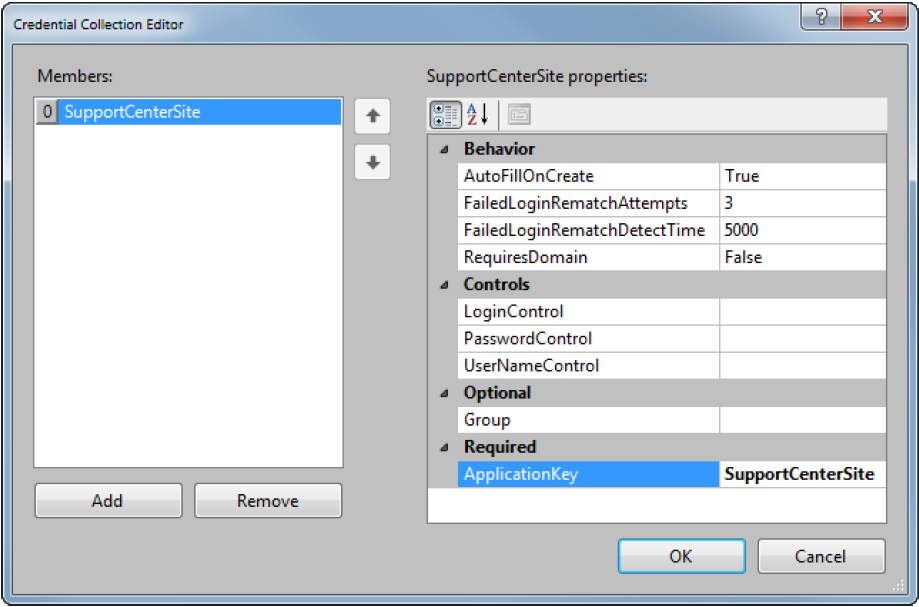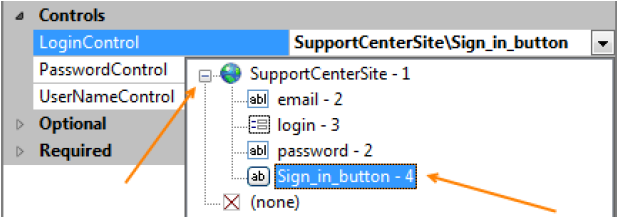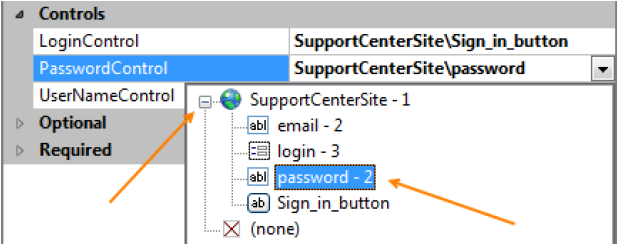Using the Credential Collection Editor
Use the Credential Collection Editor to define the information the Assisted Sign-On component needs. To define this information, perform the following steps.
In the properties for the adapter, click the button in the Credentials property:

The Credential Collection Editor is displayed.
Click Add and select the adapter. Here is an example:

Enter these properties to define credentials:
Property |
Description |
AutoFillOnCreate |
The default is True, which tells the system to automatically add the login information when the login dialog is created. Enter False if you do not want this information automatically filled in. |
FailedLoginRematchAttempts |
Enter the number of failed login attempts you will permit. The default is three (3). |
FailedLoginRematchDetectTime |
The system uses this property to prevent an infinite loop when a page rematches after a failed login attempt. For example, if invalid user credentials are entered the first time and the page rematches within the time you specify in this property, the Runtime user is automatically prompted to change his or her credentials. If the FailedLoginRematchDetectTime threshold is too low and invalid credentials are supplied, causing the controls to rematch, those credentials will automatically be used again. This will lead to an infinite loop of login attempts. This may also result in the Runtime user being locked out of the application. Enter, in milliseconds, the maximum amount of time for which a control rematch would be considered a failed login attempt and not a separate, additional login attempt. We recommend you accept the default, which is 5000, or 5 seconds. |
RequiresDomain |
In some cases, information is required in addition to the user ID and password, such as a domain name, a Personal Identification Number (PIN), a region, and so on. This is typically used by web applications. To allow this additional information, enter True. The default is False. Note: You must handle the processing of the Domain information in your automation. |
LoginControl |
Select the control used to send or process the sign-on information, such as a Sign In or Log In button. Here is an example:
|
PasswordControl |
Select the control used for the password. Here is an example:
Note: If the application does not require a password, select None. |
UserNameControl |
Select the control used for the user name, such as a name, email address, or user ID. Here is an example:
Note: If the application does not require a password, select None. |
Group |
Use this property to identify this sign-in as part of group. For instance, if you use the same sign-in user ID and password for multiple applications, you could assign all of those applications to a group, which you would identify here. This way, you only have to set up the user name and password once for all of the applications you assign to that group. Note: Make sure passwords for all of the applications in the group expire at the same time. |
ApplicationKey |
Enter the application key. This field is required and must uniquely identify the application. The system will default to the name you assigned to the adapter. Your entry will be seen by the end user on the Enter Credentials window. Include spaces if necessary to make your entry easier to read. |
Click OK when finished.



